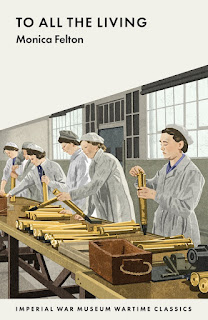In September 2021, IWM will publish another novel in their Wartime Classics Series which was launched in September 2019 to great acclaim, bringing the total number of novels in the series to eleven. Each has been brought back into print to enable a new generation of readers to hear stories of those who experienced conflict first hand.
To All the Living by Monica Felton is published by IWM and can be pre-ordered here at the online IWM shop: www.iwmshop.org.uk/pg/114/IWM-Wartime-Classics
Monica Felton (1906 – 1970) was a feminist, socialist, historian, peace activist and a pioneering proponent of town planning. She went to University College, Southampton and then did a Phd at the LSE. In 1937 she was elected a member of the London County Council representing St Pancras South West. During the Second World War she served in the Ministry of Supply, an experience she reflected in To All the Living. In 1942 she became a Clerk of the House of Commons.
After the war she became involved in town planning, serving as Chair for the Peterlee and Stevenage Development Corporations. However, she was fired from this post after taking an unauthorized trip to North Korea on behalf of the Women’s International Democratic Federation in 1951. On her return from this trip she accused American troops of atrocities and British complicity. There was a media and establishment backlash and even accusations of treason. As a result she became increasingly isolated in Britain and moved to India in 1956. She died in Madras (modern day Chennai) in 1970.
First published in 1945, To All the Living takes place in a munitions factory throughout 1941 in Blimpton, a place ‘so far from anywhere as to be, for all practical purposes, nowhere.’ The novel gives a lively account of the experiences of a group of men and women in the factory from both a top down and bottom up perspective, detailing the triumphs and tragedies of a diverse list of characters. It is wide-ranging in the themes it touches on, including class, sexism, socialism, fear of communism, workers’ rights, anti-semitism and xenophobia. Much of it was based on the author’s own experiences in the Ministry of Supply in the first years of the war, and it is one of the best depictions of factory life during wartime, providing the reader with a fascinating insight into this vital aspect of Britain’s home front.
Factory work, as depicted in the novel, could be exhausting and repetitive, with workers often receiving low pay. Initially work was on a voluntary basis which meant there was always a shortage of labour. As the war progressed, conscription for women was introduced in December 1941 to help stem the shortages. By 1945, 6.7 million women were contributing to the war effort out of a population of 48 million with a further 2.5 million in the voluntary sector. Only the Soviet Union mobilized a higher percentage of women for the war effort and the novel reflects the experiences of a tiny proportion of these women.
The work undertaken by women at munitions factories will also be explored in IWM’s new Second World War Galleries with personal items belonging to a worker at the Leeds based Blackburn Aircraft Factory on display for the first time when they open in October of this year.
Griselda Green becomes the face of munition factory workers, especially the women. The fragile balance of power, being the cog in the wheel of destruction and the crossing of boundaries when it comes to relationships, and whether the ideology contradicts and dampens said relationships.
Felton was a Jane Fonda of her era. A woman with an ideology, which was in direct contradiction to what the majority considered to be patriotic, hence the accusations of being a traitor to her country and people. A woman synonymous with fighting the injustice she perceives by the US and the complicit British.
I think it's fair to say that her own experiences during the war, which is probably what started her drive towards her political, economic and social ideologies. The injustices, the underlying sense of betrayal and abuse of power by the top echelon - the system seeped in the archaic rules of the patriarchy. All this and more is reflected in this story.
It also captures a part of wartime that is usually glossed over as the focus tends to be on action at the front, destruction and spydom, despite the fact the munition factories and workers were part of the integral structure of the war fight. I can't repeat enough how much I love the fact the Imperial War Museum is bringing all these important books back to the forefront of people's minds.
Buy To All the Living at Amazon Uk or go to Goodreads for any other retailer. Publisher : Imperial War Museum; published in Paperback 23rd September 2021 - £8.99. Buy at Amazon com.
About the Imperial War Museums - IWM
IWM (Imperial War Museums) tells the story of people who have lived, fought and died in conflicts involving Britain and the Commonwealth since the First World War.
Our unique collections, made up of the everyday and the exceptional, reveal stories of people, places, ideas and events. Using these, we tell vivid personal stories and create powerful physical experiences across our five museums that reflect the realities of war as both a destructive and creative force. We challenge people to look at conflict from different perspectives, enriching their understanding of the causes, course and consequences of war and its impact on people’s lives.
IWM’s five branches which attract over 2.5 million visitors each year are IWM London, which will open extensive new Second World War and The Holocaust Galleries in autumn 2021; IWM North, housed in an iconic award-winning building designed by Daniel Libeskind; IWM Duxford, a world renowned aviation museum and Britain's best preserved wartime airfield; Churchill War Rooms, housed in Churchill’s secret headquarters below Whitehall; and the Second World War cruiser HMS Belfast.
















































